Origins of Commemorative Coins
Where It All Began: The Spark of Commemorative Coins
Imagine holding a piece of history in the palm of your hand. That’s exactly what the first commemorative coins were meant to be—tangible snapshots of human triumphs and milestones. Their origins trace back to ancient civilizations, where rulers and empires sought creative ways to mark significant moments.
The ancient Greeks and Romans, for instance, weren’t merely minting coins for trade. Oh no, they were storytellers in metal! Some of these coins bore intricate designs celebrating things like military victories or royal marriages. Picture this: a coin minted by the Roman Emperor Nero that glorified the opening of his extravagant amphitheater. Talk about leaving a mark!
- The Greeks pioneered the idea of using coins as cultural showcases, honoring gods, athletics, and art.
- Romans elevated it further, turning coins into propaganda tools reflecting their conquests and political power.
What makes it fascinating? These weren’t just economic tools; they were emblems of pride, identity, and glory. Whether minted to celebrate a victorious battle or an enthronement, early commemorative coins were much more than currency—they were declarations of legacy.
Significant Historical Events Represented by Coins

Moments That Changed the World, Struck in Metal
Commemorative coins are more than just currency—they’re tiny time capsules that let us hold history in the palm of our hands. These coins don’t just mark a passing event; they tell stories, breathe life into moments that shaped humanity. Take, for instance, the 1969 Apollo 11 Moon Landing coin. It’s not just a shiny trinket—it’s a celebration of humanity’s leap into the cosmos, engraved with Neil Armstrong’s famous lunar footprint.
Or what about the **200th anniversary of the Declaration of Independence**? That coin sparkles with the fiery spirit of revolution, reminding us of the brave visionaries who dared to dream of liberty. Some coins even whisper tales of heroism: the rare 1914 World War I coin issued by Australia, featuring battle-hardened soldiers etched in intricate detail.
- The 1989 **fall of the Berlin Wall**, symbolizing freedom and unity.
- The 2021 coin commemorating **Florence Nightingale**, a tribute to tireless care during crises.
Each design isn’t just art; it’s emotion, legacy, and memory, pressed into a gleaming surface. Holding them feels like shaking hands with history—tangible proof of how far we’ve come.
Evolution of Designs and Materials Over Time

A Journey Through Art and Innovation
Commemorative coins are more than just gleaming pieces of metal; they’re miniature canvases, reflecting the artistry and ingenuity of their times. The earliest examples were hand-etched, showcasing simple yet symbolic designs. Imagine a craftsman, painstakingly engraving an image to honor a victory or a ruler – their hands steady, their hearts full of pride. Over centuries, these designs became more intricate, as tools grew sharper and techniques more precise.
The materials, too, have evolved in fascinating ways. Early coins were often struck in precious metals, such as gold and silver, signifying wealth and power. But creativity knows no bounds, and soon copper, nickel, and even steel found their way into the mix. Today, collectors marvel at modern coins made with unexpected combinations, like bi-metallic structures or even colorful enamel finishes.
- Medieval coins dazzled with ornate patterns yet had imperfections that told a story of human touch.
- Modern technologies, like laser engraving, allow for exquisite detail down to the tiniest speck on a design.
It’s astonishing how each coin carries not just value, but also the fingerprint of its era’s culture and craftsmanship.
Modern Uses and Collecting Trends

Commemorative Coins in Everyday Life
If you think commemorative coins are just for display cases, think again! These shimmering treasures have found their way into daily life in ways that might surprise you. While collectors may lock away a pristine coin to preserve its value, others see these coins as stylish conversation starters, unique gifts, or even lucky charms. Imagine giving a friend a coin marking the 50th anniversary of the moon landing. It’s more than a gift; it’s a piece of history they can hold!
Modern coins aren’t just about nostalgia either—they’re infused with high-tech flair. Some come embedded with holograms, glow-in-the-dark elements, or even tiny slices of meteorites. With such innovations, they’ve transformed into little artistic marvels rather than mere currency alternatives.
Trends Among Collectors and Hobbyists
What’s hot in the world of collecting? Well, here are some standout trends:
- Pop culture tributes: Think Marvel superheroes or Star Wars-themed coins thrilling fans worldwide.
- Eco-conscious designs: Coins highlighting endangered species or climate awareness campaigns for a greener future.
- Error coins: Mistakes like misprints or off-center designs turn these into rare, sought-after gems!
The collecting community has also embraced digital platforms. Online forums buzz with discussions on trade secrets, while social media shows off jaw-dropping collections. It’s not just a hobby—it’s a lifestyle!
Impact on Economies and Cultural Heritage

From Trade to Treasure: Coins Driving Economies
Commemorative coins are not just historical keepsakes—they’re economic game-changers. Picture this: a single limited-edition coin can spark a frenzy among collectors, funneling millions into a nation’s economy. Countries like Canada and Australia have mastered this art, minting beautifully crafted pieces that double as revenue streams. These coins attract both tourists and investors, creating a ripple effect of economic activity, from minting facilities to secondary markets.
Moreover, commemorative coins often serve as ambassadors of a nation’s identity. They showcase cultural symbols, achievements, or unique landmarks that fuel national pride and draw international attention. For example, the Royal Mint’s celebration of Queen Elizabeth II with a platinum jubilee coin didn’t just honor her reign—it amplified the UK’s global cultural footprint.
Preserving Stories, One Coin at a Time
Let’s not forget the emotional thread woven into every commemorative coin. Each one holds a snapshot of history—a moment frozen in metal. The 2020 Apollo 11 50th anniversary coin, for instance, doesn’t just mark mankind’s step onto the moon; it carries the hopes and dreams of a generation.
These coins become modern relics, bridging past and present. They celebrate cultures underappreciated or forgotten, like the intricately designed Maori coins from New Zealand. Every detail—from the texture to the inscription—tells a story, ensuring legacies endure across centuries. What better time capsule exists than one you can hold in your hand?





